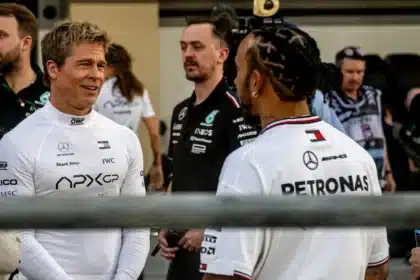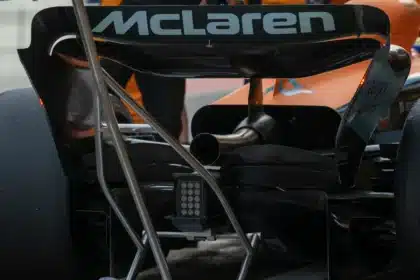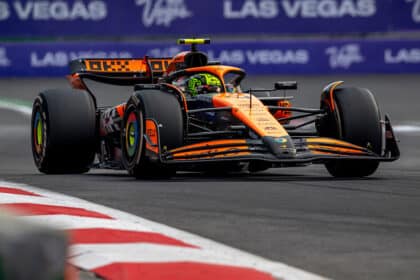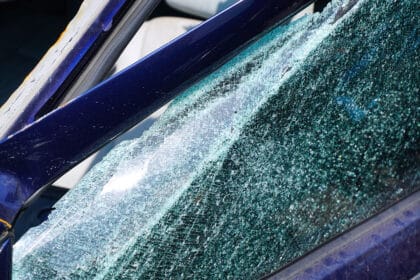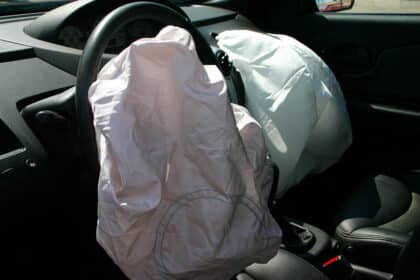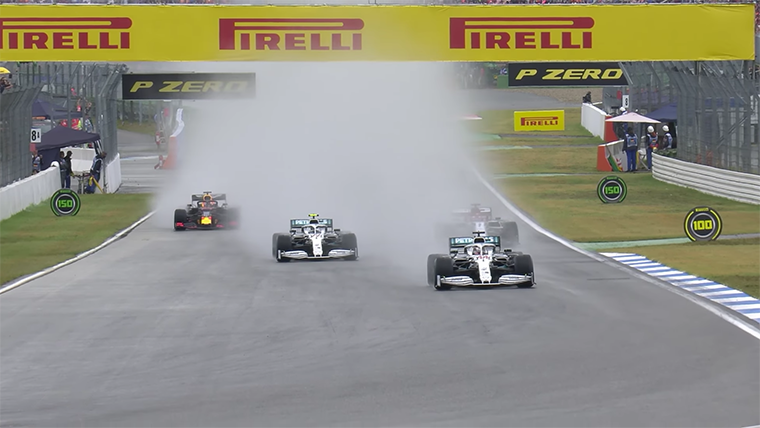 Photo: FORMULA 1 | YouTube
Photo: FORMULA 1 | YouTube 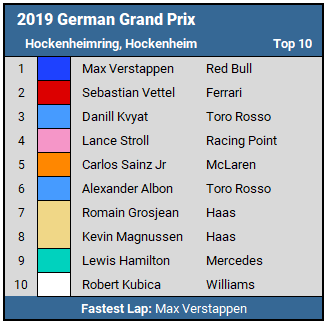
How to begin describing the 2019 German GP? It had everything. Changing weather conditions, bold strategies that worked for some teams and not others, unpredictable outcomes, spins, crashes, multiple safety cars, dramatic penalties, comeback drives and rare point opportunities for numerous drivers.
The skies opened on the morning of the race, forcing all of the teams to put the full-wet tires on their cars. Rain typically adds unpredictability, but with Hamilton on pole position, it seemed like another opportunity for the man who had won the last eight wet races to show his skills. Even more so when he got away cleanly while his main rival Max Verstappen had a horrible start and dropped to fifth.
Pit Stop: How to change your tires
It was, on the other hand, a great start for both Ferrari drivers, Vettel making up six places from 20th and Leclerc making up four places from 10th. But just three laps in, Pérez spun out of turn 11, triggering the deployment of the safety car. Most teams used this as an opportunity to swap to the intermediate tires as the track seemed to be drying, but not all — and as it would turn out, those that didn’t had made the wrong call and quickly fell behind.
By lap 10 of the 2019 German GP, Hamilton was still comfortably in the lead, but it was an all-out battle for every position behind him. Leclerc was up to fourth and Vettel up to seventh, though he seemed to have lost his momentum and couldn’t get past former teammate Räikkönen in the Alfa Romeo.
Four laps later, Ricciardo’s Renault engine blew in a fantastic cloud of smoke, and the virtual safety car was triggered to give the track marshals time to recover the car. Leclerc and Hülkenberg used this opportunity to pit again for fresh intermediates, to great effect as the latter used the extra grip to get into fifth and the former became the fastest man on the track, quickly catching the top three.
The next several laps were dominated by strategy questions. Was the track drying? Should the drivers swap to slick tires? Sainz spun on lap 19 but was able to recover, yet just four laps later, Magnussen took the gamble and put on the slicks. Vettel was next to follow, and soon after it seemed that most of the teams agreed it was the right move.
Red Bull made the questionable decision of putting Verstappen on the less grippy, medium-compound tires instead of the soft compound, though it quickly became clear that it didn’t matter. The track was still too wet. Verstappen did a 360 spin on lap 27, recovering but dropping down to sixth place, and only two laps later, Leclerc crashed from second place.
Then it was Hamilton’s turn. On lap 30 of the 2019 German GP, the five-time champion lost control of the car and nearly beached his car. He collided with the barriers on the other end of the gravel trap, destroyed his front wing and was able to limp back to the pits, though not without breaking a new rule that had been specifically named after him and introduced to prevent unsafe pit entries. His crew wasn’t ready for him and the pit stop took ages. This was somewhat mitigated by his massive lead, but he nonetheless dropped to fifth place, handing first place to teammate Bottas. He then received a five-second penalty to boot.
Verstappen retook the lead after Bottas stopped to swap back for intermediates, with Hülkenberg second and, almost unbelievably, Toro Rosso’s Albon fourth behind the safety car. Hülkenberg looked to have a good chance at finally getting his first podium finish, but as if cursed, also crashed out of the race on lap 40, triggering yet another safety car and causing drivers to pit for fresh intermediate tires once more.
Crashing Out: What to do after wrecking your car
Hamilton, however, still hadn’t pitted and lost time by being on the wrong tire — and when he did, he was required to serve his penalty, losing even more time. When he rejoined the race, he was down in 12th place. To make matters worse, he spun on lap 53 and dropped to 13th, and because the spin destroyed his tires, he pit again and fell to dead last.
Verstappen, meanwhile, was cruising to the win, while Vettel was slicing his way through the field to ultimately finish second — an amazing recovery drive after starting 20th. And who was third? Incredibly, it was none other than Daniil Kvyat, who had been fired from F1 less than two years ago, then re-hired for 2019, securing a double podium finish for Honda-powered cars, and giving Toro Rosso its first podium since Vettel’s historic 2008 win at Monza.
Hamilton ultimately finished outside of the points for the first time since 2013, but because both Alfa Romeo cars were found to have used an illegal torque-controlling system akin to traction control, they received 30-second time penalties after the race, promoting Hamilton to ninth and Kubica to 10th, giving Williams its first point of the championship.
The 2019 German GP was arguably the best race of Formula One’s hybrid engine era, and followed two races that had been excellent in their own right. Before that, after the 2019 French GP, I had been ready to call the season one of the worst I had ever watched — and I’ve been watching since 1998. How wrong I had been.
Australia | Bahrain | China | Azerbaijan | Spain | Monaco | Canada | France | Austria | Great Britain | Germany | Hungary | Belgium | Italy | Singapore | Russia | Japan | United States | Mexico | Brazil | Abu Dhabi


The News Wheel is a digital auto magazine providing readers with a fresh perspective on the latest car news. We’re located in the heart of America (Dayton, Ohio) and our goal is to deliver an entertaining and informative perspective on what’s trending in the automotive world. See more articles from The News Wheel.


